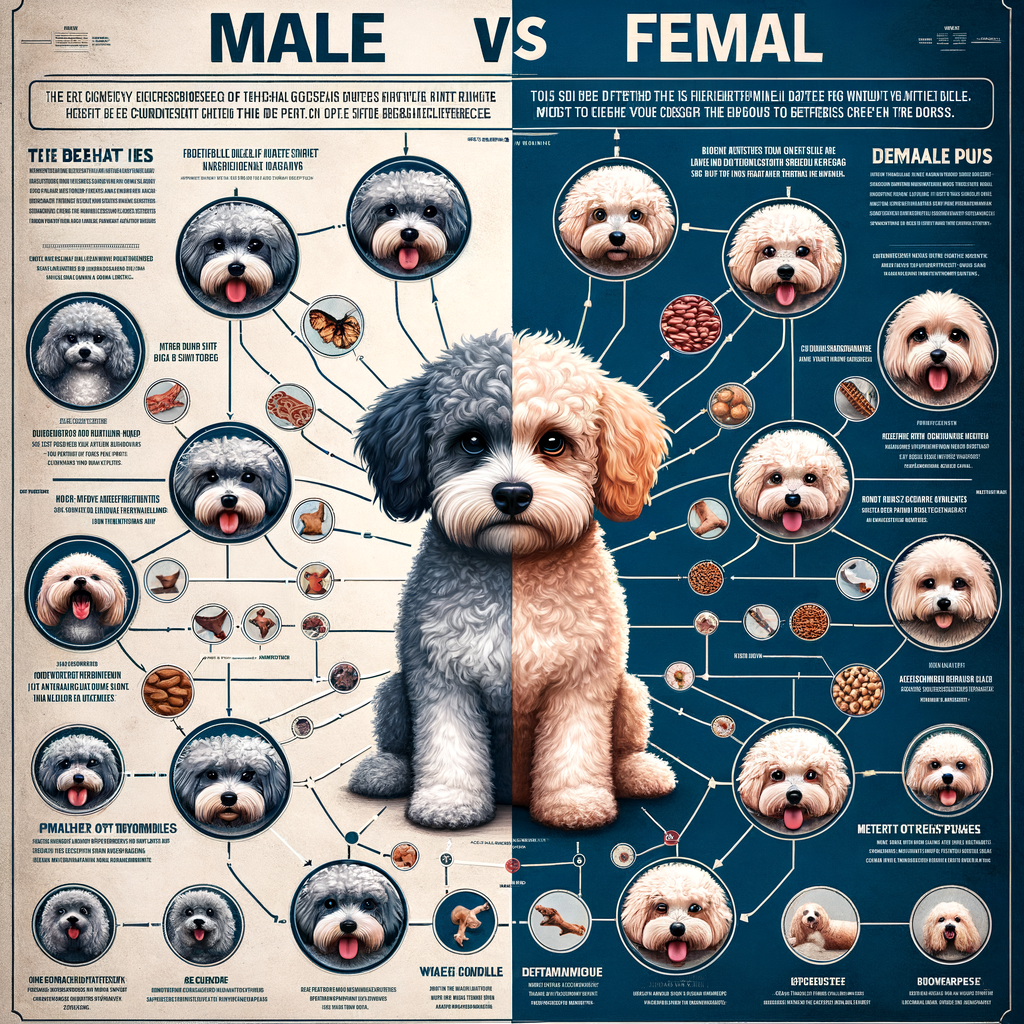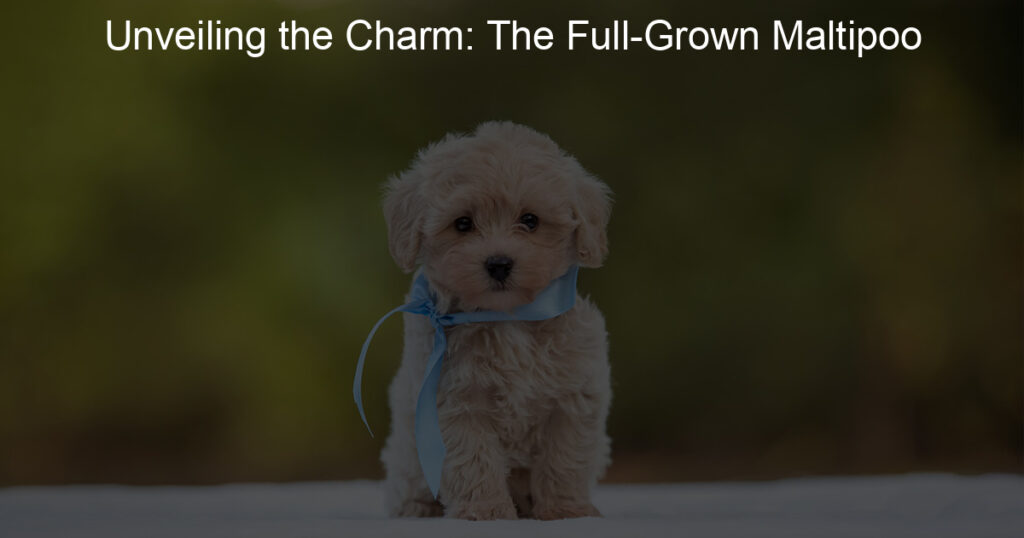
Introduction to Maltipoo Gender Differences
When it comes to choosing a pet, understanding the breed is crucial. This is particularly true for the Maltipoo, a popular hybrid breed. In this guide, we will delve into the fascinating world of Maltipoos, focusing on the differences between males and females. This knowledge will help you make an informed decision when choosing your new furry friend.
- Overview of Maltipoo breed
- Importance of understanding gender differences when choosing a Maltipoo
The Maltipoo is a crossbreed of the Maltese and the Poodle, known for its friendly nature and adorable appearance. They are small dogs, typically weighing between 5 to 20 pounds, and standing 8 to 14 inches tall. Maltipoos are intelligent, affectionate, and known for their playful energy. They are also hypoallergenic, making them a great choice for people with allergies.
Understanding the gender differences in Maltipoos is important when choosing a pet. While both male and female Maltipoos make excellent companions, there can be subtle differences in their behavior, temperament, and physical characteristics. These differences can influence your pet’s compatibility with your lifestyle and preferences. For instance, some people might prefer a more playful and energetic pet, while others might prefer a calmer and more affectionate one. By understanding these differences, you can choose a Maltipoo that is the perfect fit for your home.
In the following sections, we will explore the characteristics of male and female Maltipoos in detail, compare their behaviors, and provide factors to consider when choosing a Maltipoo. We will also share case studies to help you understand which gender might be the best fit for companionship. So, let’s dive in and learn more about these adorable creatures!
Male Maltipoo Characteristics
Understanding the characteristics of male Maltipoos can help you make an informed decision when choosing a pet. Let’s delve into the physical traits of male Maltipoos.
Physical Traits of Male Maltipoo
Male Maltipoos have unique physical traits that set them apart. These include their size and weight, and coat and color variations.
- Size and Weight
- Coat and Color Variations
Male Maltipoos are generally small dogs, typically weighing between 5 to 20 pounds. Their height ranges from 8 to 14 inches tall at the shoulder. However, the size can vary depending on the size of the parent breeds. Despite their small stature, these dogs are known for their robust energy and agility.
Maltipoos have a diverse range of coat colors and textures. Their coat is usually wavy or curly, and it’s soft to the touch. The color of their coat can vary widely, with common colors including white, cream, apricot, and silver. Some male Maltipoos may also have multi-colored coats. Regular grooming is essential to keep their coat looking its best.
Understanding these physical traits can help you better care for your male Maltipoo. Remember, each Maltipoo is unique and may not fit perfectly into these general characteristics.
Behavioral Traits of Male Maltipoo
- Temperament
- Training and Socialization
- Male Maltipoo as a Companion
The temperament of a male Maltipoo is often described as friendly, outgoing, and playful. These little dogs are known for their cheerful disposition and their love for human companionship. They are often eager to please, which makes them a joy to be around. However, they can also be quite sensitive and may not respond well to harsh training methods or negative reinforcement. Instead, they thrive in a positive, loving, and nurturing environment.
Training and socializing your male Maltipoo should start at a young age. These dogs are intelligent and quick learners, but they may also be a bit stubborn at times. Consistency and patience are key when training a Maltipoo. Use positive reinforcement methods such as treats, praise, and play to motivate your dog. Socialization is also crucial for a Maltipoo. Expose your dog to different people, environments, and other animals to help him become a well-rounded and confident adult dog.
A male Maltipoo makes an excellent companion for many types of households. Whether you’re a single individual, a family with children, or a senior citizen, a Maltipoo can fit right in. They are affectionate, adaptable, and love spending time with their human family. They also tend to get along well with other pets. However, due to their small size, they may be better suited for homes with older children who know how to handle dogs gently. Always remember, no matter the breed, every dog deserves a loving, safe, and caring home.
Female Maltipoo Traits
When it comes to the adorable Maltipoo, a crossbreed between a Maltese and a Poodle, each gender has its unique traits. In this section, we will focus on the physical characteristics of female Maltipoos.
Physical Characteristics of Female Maltipoo
Female Maltipoos, like their male counterparts, are known for their cute and cuddly appearance. However, they have some distinct physical traits that set them apart.
- Size and Weight
- Coat and Color Variations
Female Maltipoos are generally smaller and lighter than males. On average, they stand between 8 to 10 inches tall at the shoulder and weigh between 5 to 10 pounds. However, the size and weight can vary depending on the size of the parent breeds. Remember, these are averages, and individual dogs may vary.
Female Maltipoos have a soft and fluffy coat that is often a mix of the parent breeds’ colors. The coat can be straight, wavy, or curly. Common colors include white, black, brown, cream, and silver. Some may even have a combination of these colors. The coat’s color and texture can change as the puppy grows into an adult, so don’t be surprised if your Maltipoo’s coat changes over time!
Understanding these physical characteristics can help you better care for your female Maltipoo. In the next section, we will discuss the behavioral traits of female Maltipoos.
Behavioral Traits of Female Maltipoo
- Temperament
- Training and Socialization
- Female Maltipoo as a Companion
The temperament of a female Maltipoo can be described as affectionate, intelligent, and playful. They are known for their friendly nature and their ability to quickly form strong bonds with their human companions. Their high intelligence makes them quick learners, and their playful demeanor ensures they are always ready for a game or a fun activity. Despite their small size, they are quite brave and will not hesitate to protect their loved ones if they sense danger.
Training a female Maltipoo is generally an enjoyable experience due to their intelligent and eager-to-please nature. They respond well to positive reinforcement techniques such as treats, praises, and petting. Socialization is also an important aspect of their upbringing. Introducing them to different people, environments, and other animals at a young age helps them grow into well-rounded and confident adult dogs. It’s important to remember that patience and consistency are key when training and socializing your Maltipoo.
A female Maltipoo makes an excellent companion for individuals and families alike. They are known for their loyalty and their ability to adapt to different lifestyles. Whether you live in a small apartment or a large house with a yard, a female Maltipoo will be more than happy to share your space. They are also great with children and other pets, making them a perfect addition to any family. Their loving and gentle nature combined with their playful and energetic personality makes them a joy to be around.
Male vs Female Maltipoo: A Behavior Comparison
When choosing a Maltipoo, it’s important to understand the differences in behavior between males and females. This can help you make an informed decision about which gender will best suit your lifestyle and preferences. Let’s dive into the key behavioral differences between male and female Maltipoos.
- Comparison of temperament
- Comparison of trainability
- Comparison of companionship qualities
Male Maltipoos are generally more playful and energetic than their female counterparts. They love to be the center of attention and can be quite mischievous at times. On the other hand, female Maltipoos tend to be more reserved and independent. They are often more focused and serious, which can make them appear less playful but more obedient.
When it comes to trainability, both genders have their strengths. Male Maltipoos, with their playful and outgoing nature, can be quick to learn new tricks and commands, especially when motivated by treats or praise. However, their high energy levels can sometimes make them easily distracted. Females, being more focused, can excel in training sessions due to their ability to concentrate for longer periods. However, their independent nature may require a bit more patience and persistence from the trainer.
Both male and female Maltipoos make excellent companions, but they express their affection in different ways. Males are often more affectionate and eager to please their owners, making them great for families with children. They are also more likely to get along with other pets. Females, while also affectionate, can be a bit more selective about when and how they show their love. They may prefer quieter environments and can be a great choice for older individuals or those living alone.
In conclusion, both male and female Maltipoos have their unique qualities and behaviors. The choice between the two will largely depend on your personal preferences, lifestyle, and what you are looking for in a pet. Remember, every Maltipoo is an individual, and their behavior can be influenced by factors such as their upbringing, training, and socialization.
Choosing a Maltipoo: Factors to Consider
When you’re considering adding a Maltipoo to your family, there are several important factors you need to keep in mind. This decision should not be taken lightly as it involves a long-term commitment. Here are some key considerations:
- Consideration of lifestyle and living conditions:
- Consideration of family members and other pets:
- Consideration of time and commitment:
Maltipoos are active and friendly dogs that require a certain amount of exercise and social interaction. They thrive in environments where they can be part of the family activities. If you live in a small apartment, you need to ensure that you can provide enough exercise for your Maltipoo. Similarly, if you have a large yard, it should be securely fenced as Maltipoos are known for their curiosity and may wander off.
Maltipoos are generally good with children and other pets. However, it’s important to consider the age and behavior of your children and other pets. Young children should be taught how to interact with the Maltipoo in a gentle and respectful manner. If you have other pets, consider their temperament and how they might react to a new addition.
Bringing a Maltipoo into your home is a long-term commitment. These dogs live up to 15 years or more, and they require daily care, including feeding, grooming, and exercise. They also need regular veterinary check-ups. If you travel frequently or work long hours, you need to consider who will care for your Maltipoo during those times.
In conclusion, choosing to bring a Maltipoo into your home should be a decision made with careful consideration of these factors. Remember, a happy and healthy Maltipoo is one that fits well with your lifestyle and living conditions, gets along with all family members and pets, and receives the time and commitment necessary for their care.
Case Studies: Best Maltipoo for Companionship
Let’s take a look at two real-life examples that illustrate how Maltipoos can be excellent companions, regardless of their gender. We’ll explore the experiences of a family with a male Maltipoo and a single person with a female Maltipoo.
- Case Study: A Family with a Male Maltipoo
The Johnson family, consisting of two parents and two children aged 8 and 10, welcomed a male Maltipoo into their home. They named him Max. Max quickly became a beloved member of the family, displaying a playful and affectionate nature. He was easy to train, which the Johnsons attribute to his male Maltipoo characteristics. Max was particularly protective of the children, often following them around the house and even to the bus stop in the morning.
Max’s energy and playful nature kept the children entertained, while his affectionate side provided comfort and companionship to the entire family. The Johnsons report that Max’s presence has brought them closer together, proving that a male Maltipoo can indeed be a wonderful addition to a family setting.
- Case Study: A Single Person with a Female Maltipoo
Next, we have the story of Ms. Davis, a single woman living in a city apartment. She chose a female Maltipoo, Bella, as her companion. Bella’s small size was perfect for the apartment, and her calm and loving nature provided Ms. Davis with much-needed companionship.
Bella proved to be an excellent companion for Ms. Davis. She was easy to train, and her quiet demeanor made her a good fit for apartment living. Bella’s affectionate nature helped Ms. Davis feel less lonely, and taking care of Bella gave her a sense of purpose. This case study shows that a female Maltipoo can be an excellent companion for a single person, providing comfort, companionship, and a sense of responsibility.
In conclusion, both male and female Maltipoos can make excellent companions. They are adaptable, affectionate, and easy to train, making them suitable for a variety of living situations. Whether you’re a family or a single person, a Maltipoo could be the perfect addition to your home.
Conclusion: Your Maltipoo Pet Guide
In this guide, we’ve explored the world of Maltipoos, focusing on the differences between males and females. We hope this information will help you make an informed decision when choosing your new pet.
- Recap of Maltipoo Gender Differences
- Final Thoughts on Choosing the Right Maltipoo for You
Male and female Maltipoos have their unique characteristics. Males are generally more playful and energetic, while females tend to be calmer and more independent. Behaviorally, males are more likely to mark their territory, while females may show mood changes during their heat cycles. However, remember that each Maltipoo has its personality, and these are general trends, not strict rules.
Choosing the right Maltipoo for you depends on your lifestyle, preferences, and the specific traits you’re looking for in a pet. If you prefer a lively and playful companion, a male might be the right choice. If you want a more independent and calm pet, a female might be a better fit. Remember, the most important thing is that your Maltipoo fits well with your family and lifestyle.
Ultimately, the choice is yours. Whether you choose a male or female Maltipoo, you’re sure to have a loving, loyal, and adorable companion. We hope this guide has been helpful in your decision-making process. Good luck, and enjoy your journey with your new Maltipoo!








